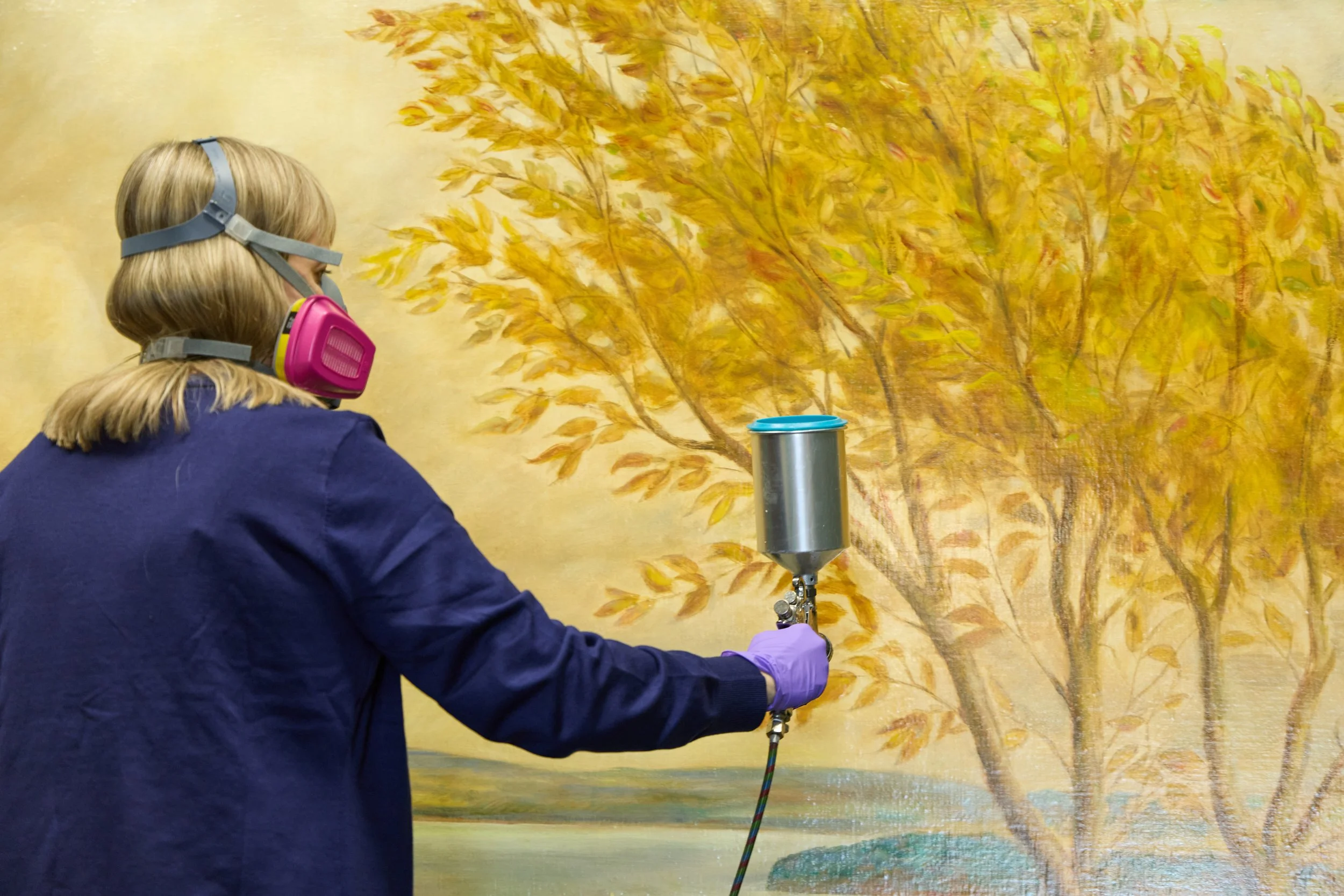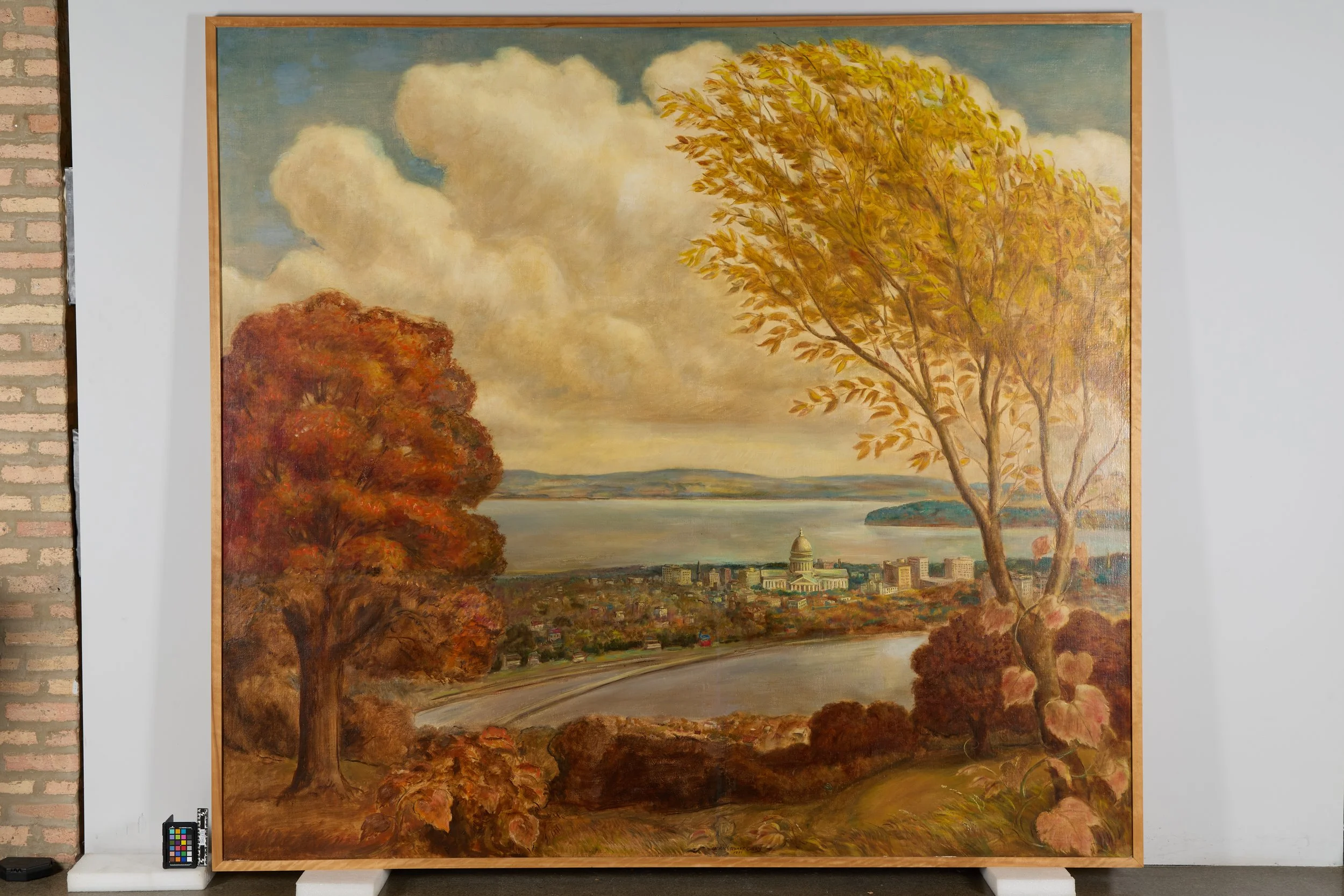We recently had the honor of treating a painting titled Madison Landscape by John Steuart Curry from the Madison Museum of Contemporary Art ; the painting is part of MMoCA’s permanent collection and will be featured in their upcoming exhibition A Broad Sweep of Sky, which explores how Regionalist artists of the 1930s and 1940s helped define a distinctly American, place-based visual identity.
Watch Amber Schabdach, head of painting conservation, treat the edges of the painting in a short video below — then scroll to learn more about the artist and our process.
Curry was born in 1897 on a farm near Dunavant, Kansas, and grew up surrounded by the livestock and rhythms of agricultural life that would later animate his paintings. He studied at the Kansas City Art Institute and the School of the Art Institute of Chicago, worked as a commercial illustrator, and spent time in Paris before turning decisively toward the American Scene and Regionalist subjects that made his reputation. Alongside contemporaries Thomas Hart Benton and Grant Wood, Curry became one of the central figures of Regionalism, championing narrative and representational depictions of rural America as an alternative to European-influenced modernism.
In 1936, Curry accepted a now-historic appointment as the first artist-in-residence at the University of Wisconsin–Madison’s College of Agriculture, a role that allowed him to travel the state, sketch farm life, and work independently while still rooted in an academic setting. During these Wisconsin years he completed murals, helped establish what became the Wisconsin Rural Arts Program (WRAP), and produced paintings that blended close observation with a quietly idealized sense of place. Madison Landscape belongs to this chapter: a 2010 review of a MMoCA exhibition on Americana described the 1941 canvas as a large, idealized autumn view of Madison that highlights the Capitol and the isthmus while deliberately leaving industrial structures on the east side outside the frame.
Before treatment.
When Madison Landscape arrived at The Conservation Center, the marks of decades of display and past interventions were visible. The painting was stretched to a non-original stretcher. The stretcher was underbuilt, and the crossbars were no longer properly secured to each other, which left the overall support vulnerable.
The original, heavy, coarsely woven canvas had been previously lined to a secondary support using wax. Excess wax remained along the reverse and edges, and the canvas sat slightly slack on its stretcher. The tacking margins had been cut away in an earlier intervention, further limiting options for tensioning the canvas. Along the bottom edge between the center and right corner, three areas of the original canvas were deformed and partially detached, and these distortions were visible above the frame line.
The canvas appeared to have been prepared with a white ground, and the paint layer displayed age-related craquelure that was overall stable and not visually disruptive. However, paint losses were present in association with the deformed areas along the bottom edge. Frame abrasions were evident on all four sides.
The surface also recorded a history of over-cleaning. The high points of the textured paint were abraded, and extensive non-original retouching had been applied in earlier treatment campaigns, including a large area in the upper left, and other scattered areas visible in normal light but not under ultraviolet illumination. These retouchings appeared to have been executed in oil paint and no longer matched the surrounding original paint. The signature at the bottom center, reading “John Steuart Curry 1941,” showed retouching in the “John” portion. Interestingly, the large rectangular area in the lower left corner was added by the artist at a later date. This area, while integrated into the canvas now, is stylistically a little different than the original paint layer but is part of the artist’s composition.
The paint layer itself was sensitive to solvents, most likely from a past intervention. Over the paint layer was a thick, discolored natural resin varnish that had been applied unevenly and was now covered in a moderate layer of surface grime, resulting in a dull, irregular surface. Because of the paint’s solvent sensitivity, this aged varnish did not appear safely removable.
Treatment began with thorough photographic documentation before and after work. Then, Amber removed surface grime by using carefully tested aqueous and dry-cleaning methods appropriate to the painting’s sensitivity. The reverse of the canvas was cleaned using a soft brush and a low-suction vacuum to remove loose dust and particulate matter.
During treatment.
The missing stretcher keys were replaced, and the crossbars of the auxiliary stretcher were secured to improve structural stability. Where necessary, the original canvas and lining were heat set to reactivate the wax lining and adhere the original canvas back in place. The stretcher was then keyed out to restore tension more evenly across the surface, helping to reduce slackness and support the deformed areas along the lower edge.
Losses along the bottom edge were filled and textured with suitable conservation fill materials selected to match the surrounding paint topography. These fills were then inpainted with reversible conservation paints, restricted to areas of genuine loss. Historic retouchings that no longer harmonized with adjacent original paint were selectively toned to better integrate into the overall image, while still remaining distinguishable on close examination and under ultraviolet light.
During treatment in our laboratory.
Because the existing natural resin varnish could not be removed safely without risking damage to the underlying paint, a new, unifying varnish layer was applied over the existing surface to even the gloss and restore a more coherent visual presentation. Finally, an acid-free Coroplast backing board was installed on the reverse of the stretcher to protect the painting from dust, handling, environmental fluctuations, and the hanging hardware was replaced as needed to ensure secure display.
During treatment.
Applying varnish.
After treatment, Madison Landscape returned to the Madison Museum of Contemporary Art stabilized, better protected, and visually refreshed, while preserving the evidence of its long life within the collection. Curry’s view of Madison, produced during his influential Wisconsin years and grounded in the ideals of Regionalism, can again be appreciated for its balance of realism and gentle idealization. For MMoCA, the painting continues to anchor conversations about American identity, place, and history; for our team, it was an opportunity to help safeguard a work that connects the museum’s collection to the broader story of Midwestern art.
After treatment.
Check out the exhibition A Broad Sweep of Sky at MMoCA December 12, 2025 – March 29, 2026.
Sources:
https://www.mmoca.org/events/sky/
https://en.wikipedia.org/wiki/John_Steuart_Curry
https://grokipedia.com/page/John_Steuart_Curry
https://wiscartists.wildapricot.org/WRAP
https://www.mmoca.org/artwork/madison-landscape-john-steuart-curry/
https://isthmus.com/arts/mmocas-apple-pie-looks-at-america-from-earnest-to-bleak/







